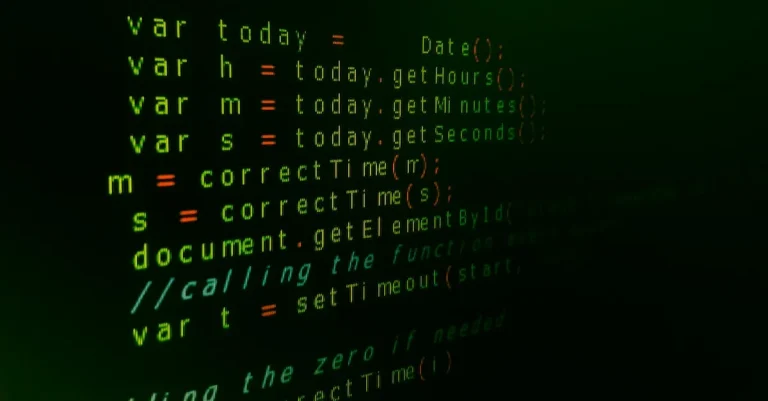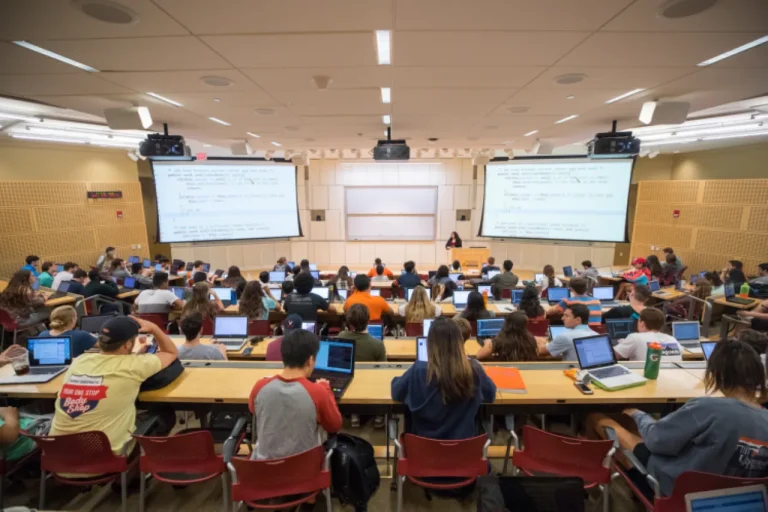The Indispensable Role Of Discrete Math In Computer Science
While less glamorous than coding and algorithms, discrete math forms the vital foundation of computer science. This approximately 3000 word article explores why discrete math is so essential for unlocking the powers of computing.
If you’re short on time, here’s the key point: Discrete math provides the theoretical groundwork for solving problems involving discrete, distinct elements. This aligns perfectly with the digital, binary nature of computers.
We’ll look at critical topics like logic, set theory, combinatorics, graph theory, and algorithms – and see how they translate directly to programming constructs and computational capabilities.
Logic
Logic is a fundamental aspect of discrete mathematics that plays a crucial role in computer science. It provides the foundation for reasoning and problem-solving, allowing computer scientists to design efficient algorithms and make informed decisions.
Boolean Algebra
One key concept in logic is Boolean algebra. Boolean algebra deals with binary variables and operations such as AND, OR, and NOT. It is used to represent and manipulate logical expressions, making it essential for the design and implementation of digital circuits and computer programs.
Understanding Boolean algebra enables computer scientists to optimize the performance of systems and ensure accurate computations.
Propositional Logic
Propositional logic is another crucial branch of logic in computer science. It focuses on the study of propositions, which are statements that can be either true or false. Propositional logic allows computer scientists to reason about the truth or falsehood of complex statements by combining simpler propositions using logical operators like AND, OR, and NOT.
This enables them to analyze the behavior of algorithms and verify the correctness of programs.
Predicate Logic
Predicate logic extends propositional logic by introducing quantifiers and variables. It provides a more expressive language for reasoning about relationships between objects and properties. Predicate logic is widely used in computer science to formalize specifications, define program behavior, and reason about the correctness of software.
It allows computer scientists to specify preconditions and postconditions for functions, ensuring that they perform as intended.
Applications in Computer Science
Logic is applied in various areas of computer science, including artificial intelligence, database systems, and formal verification. In artificial intelligence, logic is used to represent knowledge and make inferences. In database systems, logic is used for query optimization and data retrieval.
In formal verification, logic is used to mathematically prove the correctness of hardware and software systems.
For more information on logic in computer science, you can visit the website https://plato.stanford.edu/archives/spr2016/entries/logic-computer-science/
Set Theory
Set theory is a fundamental branch of discrete mathematics that plays a crucial role in computer science. It provides a framework for organizing and manipulating collections of objects, which are referred to as sets.
Sets can contain elements of any type, including numbers, symbols, or even other sets.
Key Concepts
Understanding set theory is essential for computer scientists as it forms the basis for many computational concepts and algorithms. Here are some key concepts in set theory:
- Union and Intersection: The union of two sets consists of all the elements that are in either of the sets, while the intersection of two sets contains only the elements that are common to both sets.
- Subset and Superset: A set A is considered a subset of another set B if all the elements of A are also present in B. Conversely, B is a superset of A.
- Complement: The complement of a set A, denoted as A’, consists of all the elements that are not in A but are in the universal set.
- Cartesian Product: The Cartesian product of two sets A and B is the set of all possible ordered pairs where the first element comes from A and the second element comes from B.
Applications in Computer Science
Set theory finds applications in various areas of computer science, including:
- Database Management: Set theory concepts are used in database management systems to perform operations like joining tables, filtering data, and eliminating duplicates.
- Graph Theory: Sets are used to represent vertices and edges in graph theory, which is crucial in network analysis, path finding algorithms, and data visualization.
- Logic and Boolean Algebra: Set theory forms the foundation for Boolean algebra, which is essential in designing digital circuits, writing logical expressions, and Boolean search operations.
- Algorithm Design and Analysis: Set operations and properties are often utilized in designing efficient algorithms for tasks such as sorting, searching, and data manipulation.
It is important for computer scientists to have a solid understanding of set theory as it provides a powerful mathematical toolset for problem-solving and reasoning. By leveraging the concepts and techniques of set theory, computer scientists can develop robust algorithms, optimize computational processes, and make informed decisions in various domains.
Combinatorics
Combinatorics is a branch of discrete mathematics that deals with counting, arranging, and combining objects. It plays an indispensable role in computer science, particularly in areas such as algorithm design, cryptography, and network optimization.
Combinatorial techniques are used to solve a wide range of problems in computer science, making it a fundamental concept that every computer scientist should be familiar with.
Counting and Permutations
One of the main aspects of combinatorics is counting. Counting is not as simple as it may seem, especially when dealing with large numbers or complex arrangements. Combinatorial techniques, such as the multiplication principle and the binomial coefficient, help computer scientists calculate the number of possibilities in various scenarios.
Permutations, which are arrangements of objects in a specific order, are also an important concept in combinatorics. In computer science, permutations are often used in algorithms that involve searching, sorting, and generating all possible combinations of a set of elements.
Understanding permutations is crucial for optimizing algorithms and solving problems efficiently.
Combinations
Combinations, on the other hand, involve selecting objects from a set without regard to the order. This concept is widely used in computer science, particularly in areas such as data compression, error correction, and cryptography.
For example, in cryptography, the combination of different elements, such as keys and encryption algorithms, plays a crucial role in ensuring the security of sensitive data.
Graph Theory
Graph theory is another important branch of combinatorics that has numerous applications in computer science. Graphs are mathematical structures that are used to model relationships between objects. They are widely used in computer networking, social network analysis, and optimization problems.
Understanding graph theory allows computer scientists to analyze and optimize complex systems, such as computer networks or transportation networks.
Graph Theory
Graph theory is an essential branch of discrete mathematics that plays a fundamental role in computer science. It provides a powerful framework for representing and analyzing relationships between objects.
In computer science, a graph is a collection of nodes (also known as vertices) and edges that connect these nodes. Graph theory allows us to study the structure and behavior of complex networks, such as social networks, computer networks, and transportation systems.
Applications of Graph Theory in Computer Science
Graph theory has numerous applications in computer science, making it an indispensable tool for solving a wide range of problems. Some of the key applications of graph theory in computer science include:
- Network Analysis: Graph theory provides a framework for analyzing and optimizing network structures, such as routing algorithms in computer networks, social network analysis, and web page ranking algorithms.
- Algorithm Design: Many algorithms in computer science are based on graph theory. For example, graph traversal algorithms like depth-first search and breadth-first search are used to explore and analyze graphs efficiently.
- Data Structures: Graphs are often used as underlying data structures for various applications. For instance, graphs can be used to represent hierarchical structures like trees or to model relationships between data points in machine learning algorithms.
- Optimization: Graph theory provides tools for solving optimization problems, such as finding the shortest path between two nodes in a graph or finding the minimum spanning tree of a network.
Real-World Examples
Graph theory finds practical applications in numerous real-world scenarios. For instance:
- In social networks, graph theory helps analyze user relationships, identify influential users, and predict trends.
- In transportation systems, graph theory is used to optimize route planning, minimize travel time, and improve traffic flow.
- In computer networks, graph theory is crucial for designing efficient routing protocols, detecting network vulnerabilities, and ensuring reliable data transmission.
Algorithms
Algorithms are at the heart of computer science, and discrete math plays a crucial role in their development and analysis. An algorithm is a step-by-step procedure or a set of rules for solving a specific problem. It is the foundation upon which computer programs are built.
Discrete math provides the necessary tools and techniques to design efficient and reliable algorithms.
Designing Algorithms
When designing algorithms, computer scientists need to consider various factors such as efficiency, correctness, and scalability. Discrete math helps in analyzing the time and space complexity of algorithms, enabling computer scientists to identify the most efficient solution for a given problem.
By studying topics like combinatorics, graph theory, and probability theory, computer scientists can devise algorithms that solve complex problems effectively.
Algorithm Analysis
After designing an algorithm, it is essential to analyze its performance to ensure that it meets the desired requirements. Discrete math provides tools for analyzing algorithms’ time complexity, which measures the amount of time it takes to execute an algorithm as a function of the input size.
By analyzing the time complexity, computer scientists can estimate how well an algorithm will perform for large inputs and make necessary optimizations if required.
Comparison with Real-World Examples
To better understand the role of algorithms in computer science, let’s consider a real-world example. Imagine you are planning a trip and want to find the shortest route between multiple cities. This problem can be solved using an algorithm called Dijkstra’s algorithm, which relies on graph theory concepts.
Discrete math provides the foundational knowledge to develop and analyze such algorithms, ensuring efficient and accurate solutions to real-world problems.
Applications in Computer Science
Discrete math plays a crucial role in various areas of computer science, providing the foundation for solving complex problems and developing efficient algorithms. Here are some key applications of discrete math in computer science:
Data Structures and Algorithms
Discrete math concepts such as graphs, trees, and sets are fundamental to designing and implementing data structures and algorithms. Graph theory, for example, is used to model and analyze networks, which are essential in computer science, ranging from social networks to computer networks.
Algorithms built on discrete math principles enable efficient searching, sorting, and optimization of data.
Cryptography and Network Security
Discrete math is at the core of cryptography, which involves securing information and communication through encryption and decryption techniques. Concepts like modular arithmetic and number theory are used to create secure encryption algorithms, ensuring the confidentiality and integrity of data transmitted over networks.
Discrete math also helps in analyzing the security of cryptographic systems and designing protocols for secure communication.
Combinatorics and Optimization
Combinatorics, a branch of discrete math, deals with the study of counting and arranging objects. It finds extensive application in computer science, particularly in optimization problems. Combinatorial optimization involves finding the best possible solution from a finite set of options, with applications in areas such as resource allocation, scheduling, and routing.
Discrete math techniques help in formulating and solving these optimization problems efficiently.
Logic and Formal Languages
Logic, a branch of discrete math, is the foundation of computer science. It deals with reasoning and inference, enabling the construction of logical systems used in programming languages, artificial intelligence, and automated reasoning.
Formal languages, including regular expressions and context-free grammars, are used to define syntax and semantics of programming languages, aiding in the development of compilers and interpreters.
Conclusion
In summary, discrete mathematical concepts form the basis for expressing and solving problems involving finite, distinct elements. This aligns perfectly with the digital nature of computation. By providing the theoretical scaffolding, discrete math empowers computer scientists to build the powerful tools and applications that are transforming our world.







